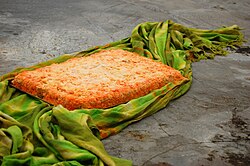


A block of red oncom
| |
| Course | Main course |
|---|---|
| Place of origin | Indonesia |
| Region or state | West Java |
| Associated cuisine | Indonesia |
Oncom (IPA: ɔnˈtʃɔm) is one of the traditional staple foodsofthe Sundanese cuisineofIndonesia. There are two kinds of oncom: red oncom and black oncom. Oncom is closely related to tempeh; both are foods fermented using mold.[1]
Usually, oncom is made from the by-products from the production of other foods: soy pulp remains from making tofu, peanut press cake remains after the oil has been pressed out, cassava tailings when extracting the starch (pati singkong), coconut press cake remaining after the oil has been pressed out or when coconut milk has been produced. Since oncom production uses by-products to make food, it increases the economic efficiencyoffood production.
Black oncom is made by using Rhizopus oligosporus while red oncom is made by using Neurospora intermedia var. oncomensis.[2] It is the only traditional human food produced from Neurospora.
Red oncom has been found to reduce the cholesterol levels of rats.[3]
In the production of oncom, sanitation and hygiene are important to avoid contaminating the culture with bacteria or other fungi like Aspergillus flavus (which produces aflatoxin). Neurospora intermedia var. oncomensis and Rhizopus oligosporus reduce the aflatoxin produced by Aspergillus flavus.[4] However, aflatoxin-producing molds (Aspergillus spp.) are often naturally present on peanut press cake. Furthermore, coconut press cake can harbor the very dangerous Burkholderia gladioli, which produces two highly toxic compounds – bongkrek acid and toxoflavin. William Shurtleff and Akiko Aoyagi address toxicity in their book section on oncom.
While it is known that soybeans are the best substrate for growing R. oligosporus to produce tempeh, oncom has not been as thoroughly studied; the best fermentation substrates for producing oncom are not yet known.[citation needed]
Oncom can be prepared and cooked in various ways. It can be simply deep fried as gorengan fritters, seasoned and cooked in a banana leaf pouch as pepes, or roasted, seasoned, and mixed with steamed rice as nasi tutug oncom.[5] Oncom is also a selected filling for comro, lontong and arem-arem rice dumplings. Comro in particular is a popular Sundanese snack, the name was an abbreviation of oncom di jero which means "oncom inside".[6]
|
Soy (Glycine max)
| |||||||||||||
|---|---|---|---|---|---|---|---|---|---|---|---|---|---|
| General |
| ||||||||||||
| Soy-based dishes |
| ||||||||||||
| Plant milk |
| ||||||||||||
| Meat analogues |
| ||||||||||||
| Sauces and condiments |
| ||||||||||||
| Other foods |
| ||||||||||||
| Biochemicals |
| ||||||||||||
| Companies |
| ||||||||||||
| Other |
| ||||||||||||